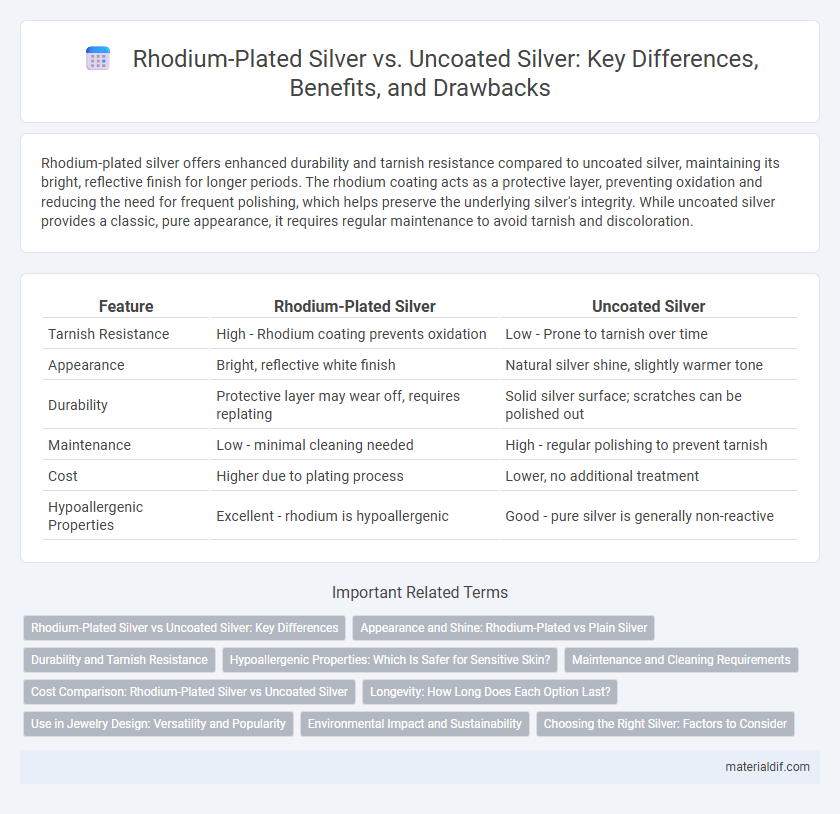Rhodium-plated silver offers enhanced durability and tarnish resistance compared to uncoated silver, maintaining its bright, reflective finish for longer periods. The rhodium coating acts as a protective layer, preventing oxidation and reducing the need for frequent polishing, which helps preserve the underlying silver's integrity. While uncoated silver provides a classic, pure appearance, it requires regular maintenance to avoid tarnish and discoloration.
Table of Comparison
| Feature | Rhodium-Plated Silver | Uncoated Silver |
|---|---|---|
| Tarnish Resistance | High - Rhodium coating prevents oxidation | Low - Prone to tarnish over time |
| Appearance | Bright, reflective white finish | Natural silver shine, slightly warmer tone |
| Durability | Protective layer may wear off, requires replating | Solid silver surface; scratches can be polished out |
| Maintenance | Low - minimal cleaning needed | High - regular polishing to prevent tarnish |
| Cost | Higher due to plating process | Lower, no additional treatment |
| Hypoallergenic Properties | Excellent - rhodium is hypoallergenic | Good - pure silver is generally non-reactive |
Rhodium-Plated Silver vs Uncoated Silver: Key Differences
Rhodium-plated silver features a thin layer of rhodium over the silver surface, enhancing durability, tarnish resistance, and providing a bright, reflective finish compared to uncoated silver. Uncoated silver is prone to oxidation and tarnishing, requiring regular cleaning to maintain its luster. The rhodium plating significantly extends the lifespan and aesthetic appeal of silver jewelry by offering superior protection against scratches and environmental damage.
Appearance and Shine: Rhodium-Plated vs Plain Silver
Rhodium-plated silver offers a brighter, more reflective surface with a lustrous, white finish that resists tarnishing, enhancing long-term shine compared to uncoated silver's natural, warmer patina. Plain silver develops a subtle tarnish over time, which can dull its appearance unless regularly polished. The rhodium coating provides a protective barrier, maintaining a consistently polished, high-gloss look preferred for jewelry and decorative pieces.
Durability and Tarnish Resistance
Rhodium-plated silver offers superior durability compared to uncoated silver, as the rhodium layer acts as a protective barrier against scratches and everyday wear. This plating significantly enhances tarnish resistance by preventing oxidation, which commonly causes silver to darken over time. Uncoated silver, while maintaining its natural luster, requires frequent polishing to manage tarnish and is more susceptible to surface damage.
Hypoallergenic Properties: Which Is Safer for Sensitive Skin?
Rhodium-plated silver offers superior hypoallergenic properties compared to uncoated silver, as the rhodium layer acts as a protective barrier preventing skin contact with potentially irritating alloys often found in sterling silver. Uncoated silver, while generally safe, can cause allergies in sensitive individuals due to the presence of copper or nickel alloys. Therefore, rhodium plating is safer for sensitive skin, reducing the risk of allergic reactions and skin irritation.
Maintenance and Cleaning Requirements
Rhodium-plated silver requires less frequent cleaning and is more resistant to tarnish compared to uncoated silver, which oxidizes and darkens over time. Cleaning rhodium-plated pieces is simpler, usually needing only a gentle wipe with a soft cloth, while uncoated silver demands regular polishing with specialized silver cleaners to maintain its shine. The rhodium layer acts as a protective barrier, reducing oxidation and minimizing the need for intensive maintenance.
Cost Comparison: Rhodium-Plated Silver vs Uncoated Silver
Rhodium-plated silver typically incurs higher costs due to the added rhodium coating process and material expenses, which increase durability and tarnish resistance compared to uncoated silver. Uncoated silver is generally less expensive but requires more maintenance to prevent tarnishing and may need occasional polishing or re-coating to maintain its appearance. When comparing initial investment and long-term upkeep, rhodium-plated silver offers a cost-effective solution for those prioritizing durability and low maintenance despite the higher upfront price.
Longevity: How Long Does Each Option Last?
Rhodium-plated silver offers enhanced longevity by providing a durable protective layer that resists tarnish and scratches, extending the lifespan of silver jewelry significantly beyond that of uncoated silver. Uncoated silver typically begins to tarnish within a few months to a year, requiring regular polishing to maintain its shine. Rhodium plating can last anywhere from one to several years depending on wear and care, making it a superior choice for long-term durability.
Use in Jewelry Design: Versatility and Popularity
Rhodium-plated silver offers enhanced durability and a brilliant, tarnish-resistant finish, making it highly popular in contemporary jewelry design for maintaining a polished appearance over time. Uncoated silver, prized for its authentic luster and ease of reshaping, remains a favorite among designers seeking a classic, natural look in versatile pieces. The choice between rhodium-plated and uncoated silver depends on the desired aesthetic and functional longevity, influencing trends in rings, bracelets, and necklaces.
Environmental Impact and Sustainability
Rhodium-plated silver involves coating silver jewelry with a thin layer of rhodium, a rare and energy-intensive metal, which increases environmental impact due to mining and refining processes. Uncoated silver offers a more sustainable option as it avoids the additional resource extraction and chemical use associated with rhodium plating, reducing ecological footprint. Choosing uncoated silver supports eco-friendly practices by minimizing processing steps and promoting recyclability without compromising quality.
Choosing the Right Silver: Factors to Consider
Rhodium-plated silver offers enhanced tarnish resistance and a brighter, more durable finish compared to uncoated silver, making it ideal for jewelry subjected to frequent wear. Uncoated silver, while prone to oxidation and requiring regular maintenance, provides a natural luster and is often preferred for its authentic appearance and affordability. Factors such as durability, maintenance, expected use, and aesthetic preference are crucial when choosing between rhodium-plated and uncoated silver.
Rhodium-Plated Silver vs Uncoated Silver Infographic

 materialdif.com
materialdif.com